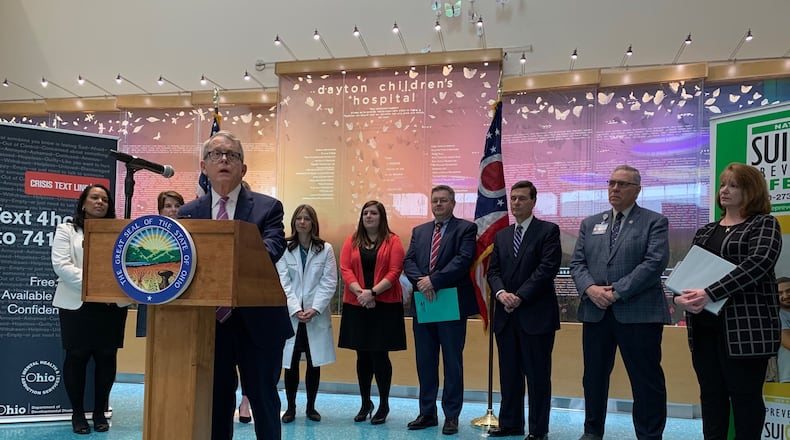READ MORE: ‘Kids coming to school with more trauma:’ Here’s what local schools are doing
The plan also calls for standardizing, gathering and using data to address the public health crisis. The state will partner with Ohio children’s hospitals to increase suicide prevention and intervention efforts.
“We really have, in Ohio, a mental health crisis. It’s a mental health crisis that’s a real threat to our families. It’s something we absolutely have to focus on,” DeWine said.
DeWine noted that his two-year state budget includes $675 million for K-12 schools to spend on wellness initiatives, including hiring mental health specialists. He said he’ll push to renew that money and add to it in his next state budget proposal.
RELATED: Suicides dramatically increasing across Ohio, report finds
Between 2007 and 2018, suicide deaths increased 45 percent among all age groups and by 56 percent among youths ages 10 to 24, according to state health officials. Since 2007, 20,196 people in Ohio have died by suicide, including 1,715 in 2019 and 90 so far this year, according to the latest data from the state department of health.
The most common method of suicide is firearms. Across the country, six in 10 firearms deaths are suicides.
DeWine said his Strong Ohio plan to address gun violence, Senate Bill 221, will save people. “Yes, I’m sure it’ll prevent some suicides.”
“When someone dies by suicide it impacts an entire community. It doesn’t just impact a family, it impacts an entire community and it shakes that community to its core,” said Tony Coder, director of the Ohio Suicide Prevention Foundation.
People need to change their own approach to the issue, Coder said, noting that families dealing with cancer are offered support and empathy but the same isn’t extended to families who struggling with suicide.
Warning signs of suicide include: major change in mood or behavior; high-risk behaviors such as drug use; expressing feelings of hopelessness; self-harm such as cutting or burning; change in energy, appetite or sleep schedule.
RELATED: How Dayton region can stop record increase in teen suicides
Experts suggest the following ways to help someone showing warning signs: ask directly about suicidal thoughts; listen to their needs; keep lethal means away from them; call 911 if necessary; connect them with the National Suicide Prevention hotline at 1-800-273-8255; and encourage them to seek counseling.
RELATED: Ohio lawmakers vote to increase suicide prevention training in schools
Suicide is a complex problem with multiple risk factors. Root causes of depression and anxiety include a lack of healthy coping skills; barriers to receiving care, including stigma; high levels of stress and trauma due to loss of jobs, the addiction crisis and high rates of domestic violence; and a lack of community connectedness.
People contemplate suicide for lots of reasons, Ohio Department of Mental Health and Addiction Services Director Lori Criss.
“The important thing is to recognize that contemplating suicide and those thoughts are usually brief and if there is an opportunity to create that environment where kids feel safe talking at home, at school, to trusted adults, to their friends, then that time can be intervened and there can be services that help them not contemplate suicide,” she said.
RELATED: Advocates say Ohio needs to improve enforcement of key health care law
Insurance companies are required by federal law to cover mental health and drug addiction issues on par with physical illness.
The DeWine administration is working to improve state websites and education material to help consumers understand the “mental health parity” law, Criss said.
DeWine encouraged Ohioans who believe they’re not receiving legally required insurance benefits to make a complaint to state authorities.
“We’re not seeing that happen,” he said. “That needs to happen when people are finding there is in fact a problem.”
If you or someone you know is in crisis, contact the National Suicide Prevention hotline at 1-800-273-8255 or text 4hope to 741 741.
About the Path Forward
Our team of investigative reporters digs into what you identified as pressing issues facing our community. The Path Forward project seeks solutions to these problems by investigating the Miami’s Valley mental health. Follow our work at DaytonDailyNews.com/PathForward or join one of our Facebook Groups.
About the Author

